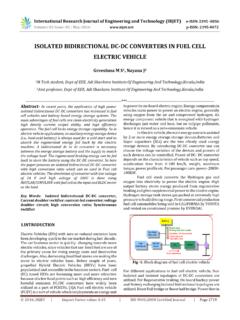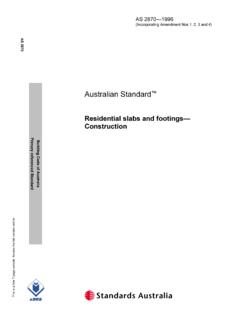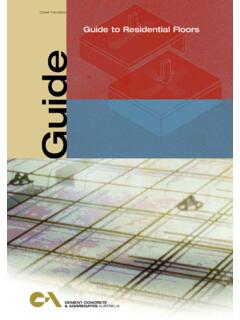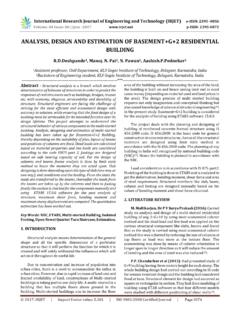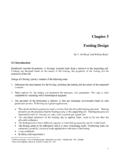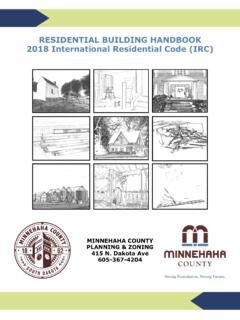Transcription of Design and Analysis of Residential Building
1 International Research Journal of Engineering and Technology (IRJET) e-ISSN: 2395-0056 Volume: 06 Issue: 04 | Apr 2019 p-ISSN: 2395-0072 2019, IRJET | Impact Factor value: | ISO 9001:2008 Certified Journal | Page 2733 Design and Analysis of Residential Building Shaikh Ibrahim1, Md Arifuzzaman2, Jisan Ali Mondal3, Md Taukir Alam4, Sanuwar Biswas5, Sagar Biswas6 1 Assistant professor, Civil Department, Jamia Institute of Engineering and Management Studies, Akkalkuwa, Maharashtra, India 2,3,4,5,6 Bachelor of Engineering Student, Jamia Institute of Engineering and Management Studies, Akkalkuwa, Maharashtra.
2 India ---------------------------------------- -----------------------------**--------- ---------------------------------------- ---------------------Abstract - This Project is Generally Based on Theoretical Design And Analysis of structural framed Building . Planning, Analysis and Design of G+4 Residential Building structure by using IS-Code method , manually designed and over verifies by using software. Planning of any types of Building is done by national Building code (NBC) in India, Hence the Residential Building is properly planned in accordance with the national Building code of India. The reinforced concrete framed structure consisting of G+4 with adequate facilities.
3 All the structure member are designed using limit state method with reference of IS:456-2000. Different load active on the member (beam, column) are considered according to the code IS:875(part1,part2,part3). Key Words: Residential Building , Staad-pro V8i Analysis , Multi-stories Building , Design and Analysis of Framed Building , NBC. 1. INTRODUCTION Now a days due to overpopulation and high cost of land, multi-storied Building is more essential for metropolitan city. Multi-storied Residential Building is the perfect solution for living of high populated area. A multi-storied Building , which posses multiple floor above the ground level, which aim to increase the floor area of Building in shortest built up area.
4 Structure Analysis is a subject which involves designing, planning to built up a perfect Building . Basically each project are different with their Design criteria such as incoming load, soil properties, dynamic load, built up area etc. Here we provided the details to complete a Residential apartment theoretically. We firstly collected some required data to measure the soil specific such as moisture content, bearing capacity of soil, types of soil etc. We provided the perfect parameter in beam, slab, column and footing with the consideration of incoming load to avoid shear and bending collapse. In accordance with limit state method of collapse in IS-456:2000 we built G+4 Building which deal with strength and stability of structure under maximum Design load flexure, compression , shear and torsion.
5 2. LETARATURE REVIEW: Chandurkar et. al. (2013): Study of G+9 Building : Had presented study of G+9 Building having three meters height for each storey. The whole Building Design had carried out according to IS code for seismic resistant Design and the Building had considered fixed at base. Structural element for Design had assumed as square or rectangular in section. They had done modelling of Building using ETAB software in that four different models were studied with different positioning of shear walls. Mohit Sharma (2015): To study the dynamic Analysis of multi-storeyed Building : He considered a G+30 storied regular reinforced concrete framed Building .
6 Dynamic Analysis of multi-storeyed Building was carried out. These buildings have the plan area of 25m x 45m with a storey height each and depth of foundation is m. & total height of chosen Building including depth of foundation is 114 m. The static and dynamic Analysis has done on computer with the help of STAAD-Pro software using the parameters for the Design as per the IS:1893-2002 Part-1 for the zones- 2 and 3. It was concluded that not much difference in the values of Axial Forces as obtained by static and dynamic Analysis . M. S. Aainawala et. al. (2014): Comparative study of multi-storeyed Buildings with and without Shear Walls: He did the comparative study of multi-storeyed Buildings with and without Shear Walls.
7 They applied the earthquake load to a Building for G+12, G+25, G+38 located in zone II, zone III, zone IV and zone V for different cases of shear wall position. They calculated the lateral displacement and story drift in all the cases. It was observed that Multi-storeyed Buildings with shear wall is economical as compared to without shear wall. As per Analysis , it was concluded that displacement at different level in multi-storeyed Building with shear wall is comparatively lesser as compared to Building without shear wall. Which is important for Building Design and use of shear walls. M. Mallikarjun et. al. (2016): on Analysis and Design of a multi-storied Residential Building of ung-2+G+10: Carried study on Analysis and Design of a multi-storied Residential Building of ung-2+G+10 by using most International Research Journal of Engineering and Technology (IRJET) e-ISSN: 2395-0056 Volume: 06 Issue: 04 | Apr 2019 p-ISSN: 2395-0072 2019, IRJET | Impact Factor value: | ISO 9001.
8 2008 Certified Journal | Page 2734 economical column method and the dead load and live load was applied on the various structural component like slabs, beams and found that as the study is carried using most economical column method this was achieved by reducing the size of columns at top floors as load was more at the bottom floor. The economizing was done by means of column orientation in longer span in longer direction as it will reduce the amount of bending and the area of steel was also reduced. 3. METHODOLOGY 4. WORK PROGRESS BASIC DATA i. Type of Building Residential Building . ii. Type of structure multi storey rigid jointed framed iii.
9 No. of storey 5 (G+4) iv. Floor to floor height m. v. External walls 230 mm including plaster vi. Internal walls 150 mm inculing plaster vii. Bearing capacity of soil 200 KN/m2 viii. Height of plinth m. NOTE:-Others required data assume using NBC(national Building code) for planning and IS:456-2000 for concrete Design work. PLAN OF Residential Building Fig1: Plan of Residential Building . Design OF Building COMPONENTS Design OF SLAB Given data : Lx = m Ly = m Ly/Lx = < 2 hence it s a two way slab Live load = 2 KN/M2, Floor finish = 1 KN/M2 M. Factor = [ For HYSD ] L/d = 28 x =>3360/d = 28 x d = Assume D=140mm and d=120mm . Effective span : Width of the support = 230mm Clear span = 3360 + 230 = 3590 mm 1/12 x 3590 = mm > 230 mm Ly = 3590 mm & Lx = 4120 mm Load calculation: Self-weight of slab = 0.
10 140 x 25 = KN/M2 Live load = 1KN/M2 Floor finish = 2 KN/M2 Ultimate load = x = KN/M2 Moment calculation: Mx = x x w x lx2 My = y x w x lx2 Ly/Lx = [ From table 26 page- 91 IS 456 ;2000 ] x = & y = Mx = x x = My = x x = Check for flexure: dx provide = D -15 -10/2 = 120 MM dy provide = d -10/2 = 115 MM Mu = Mulimit x 106 = x 20 x 1000 x d2 drequired.( mm)<dprovided(120mm) :: Hence safe in flexure Reinforcement calculation: Astx = ( ) 120 x 1000 = mm2 International Research Journal of Engineering and Technology (IRJET) e-ISSN: 2395-0056 Volume: 06 Issue: 04 | Apr 2019 p-ISSN: 2395-0072 2019, IRJET | Impact Factor value: | ISO 9001:2008 Certified Journal | Page 2735 Spacing along X direction- = = = 245 = 220 mm say Provide 10 mm @220 mm c/c.







